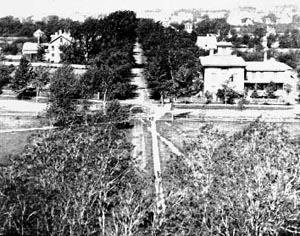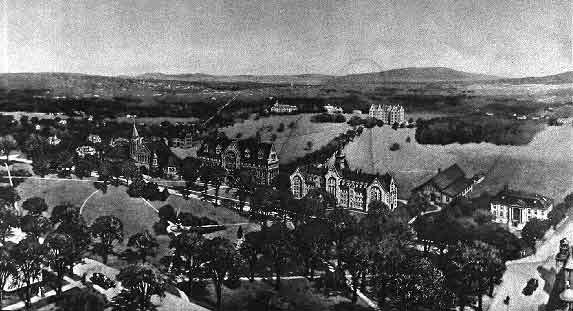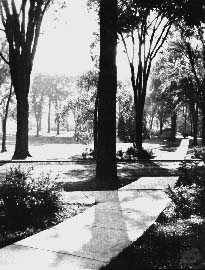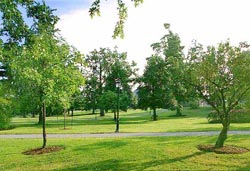

| SEARCH |
| UVM A-to-Z |
| UVM PEOPLE |
| UVM HOME |
|
|
|
|
|
|
|
|
|
|
 The University Green
The University Green
The University of Vermont was chartered in 1791, upon approval of the legislature, after Vermont was officially admitted to the United States as a state in that same year. Ira Allen, brother of Ethan Allen, had suggested the idea of a state university, lobbied for a Burlington location, and donated the initial land for it.
Right: This circa 1860 stereopticon view looking west toward College Street shows the work of the Class of 1837, with the fencing, gates, pathways, and wagon ruts. (UVM Archives)
According to an account by E.L. Walbridge (Class of 1917) in the Ariel of 1929, the initial donation was fifty acres, of which ten were cleared of "stately pines." There has been much speculation about the legendary pines of the original land; rumor has long held that their wood was used to build the first college building in 1800, on the site of the present Old Mill, but this has not been substantiated. At any rate, documentation seems to make clear that for the first thirty or forty years of the University's existence, the Green was an uncultivated field. In fact, in the 1893 Ariel, Amos A. Parker, a graduate of the Class of 1813, contributes a memoir which includes stories of students in his time having to fight off sheep from neighboring farms, because the Green "grew the best grass." Mr. Parker also settles a few other mysteries of the Green's history, such as confirming that the Green was indeed used as a military encampment for the War of 1812. He speaks of great festivals, political rallies and celebrations being held on the Green, featuring roasted oxen and giant tents, often even including burning effigies and other rowdiness.
The first step away from the Green as open pasture was a student initiative of 1833, in which the Class of 1837 contributed a fence around the Green. The students also built a gate at the spot where College Street meets the Green; this gate was in place until 1874.
According to Ariel of 1904, these students "laid out and graded the walks, set trees, built a strong and handsome fence with turnstiles at the entrances to the paths, and two handsome gateways opposite the College."

(UVM Library Special Collections)
This student initiative involved the planting of American Elms in allees around the edges of the Green and along pathways in its interior. These elms are the ones which, by the turn of the century, had achieved heights of great shady stateliness and very much dominated the visual appearance of the Green from 1900 through the 1940s. By the late 1960s, the elms had fallen prey to Dutch elm disease, as did the majority of elms across America. This more than any other single factor has affected a change in the appearance of the University Green. In 1998, only two American elms remained on the Green.
 Above:
Artists rendering of the Green with mature elms lining the walkways
and streets, before 1925.
Above:
Artists rendering of the Green with mature elms lining the walkways
and streets, before 1925. (UVM Library Special Collections)
Thus, over time the Green has differed vastly in its feelings and association, from an open pasture to a lush Beaux Arts park to today's still park-like but more modern, half-open, low-lying setting.
 By 1834, the first pathways were installed
on the Green, creating a main axis from College Street to the
center of Old Mill, with auxiliary diagonals feeding off of it.
More paths were added by 1910, and some axes had been altered
by the late 1930s. Since at this same time, the aforementioned
elm trees planted in the 1830s initiative had grown to maturity,
a well-ordered but lush park-like setting was created. While
some edges or boundaries of the Green when viewed from its exterior
might give the impression of a dense forest, once inside the
Green or on the adjacent University Place, the eye was led down
allees and avenues of shady greenery which took one directly
to the main buildings of campus.
By 1834, the first pathways were installed
on the Green, creating a main axis from College Street to the
center of Old Mill, with auxiliary diagonals feeding off of it.
More paths were added by 1910, and some axes had been altered
by the late 1930s. Since at this same time, the aforementioned
elm trees planted in the 1830s initiative had grown to maturity,
a well-ordered but lush park-like setting was created. While
some edges or boundaries of the Green when viewed from its exterior
might give the impression of a dense forest, once inside the
Green or on the adjacent University Place, the eye was led down
allees and avenues of shady greenery which took one directly
to the main buildings of campus.
Right: Concrete walks crossing the University Green, flanked by American elms, in the 1930s. (UVM Library Special Collections)
Student sentiment about the Green was probably at its height in the first half of the twentieth century. This can be seen in the designations of certain allees in the University yearbooks with such fond names as "Campus Walk." Students also wrote poems about the Green published in Ariel and conducted elaborate initiation rituals of younger students on the Green.
 1940 saw the erection of the Waterman
Building on South Prospect Street and a realignment of the
Green's main axis. This is the configuration of pathways in place
today.
1940 saw the erection of the Waterman
Building on South Prospect Street and a realignment of the
Green's main axis. This is the configuration of pathways in place
today.
Right: Postcard view of the UVM Green looking west toward Waterman Building, 1960s, with 1880s fountain sitll in place. By the 1970s, the fountain had been removed and placed in storage. It was returned to this location on the Green (shown below right) in the 1980s through the efforts of a senior class gift, the UVM President's Office and the UVM Historic Preservation Program.
 |
Although the elm trees are gone, the Green's pathways remain, yet one has to question whether, in the current configurations of smaller tress planted in isolated cluster patterns (below), the walkways work any longer toward the kind of organic unity which existed during the first half of the twentieth century.
|
- (Text from "The University Green: A Brief Study of Its History and Features with Treatment Recommendations Based on the National Park Service Historical Landscapes Intitiative", by Barb Shubinski '98. Student paper for HP 307, Advanced Architectural Conservation, Prof. Thomas Visser, University of Vermont Graduate Program in Historic Preservation, April 1998.)
